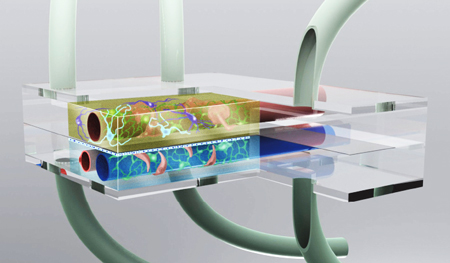2012 Tissue Chip Project Awards
On July 24, 2012, NIH issued 17 awards for research projects designed to create 3-D chips with living cells and tissues that accurately model the structure and function of human organs, such as the lung, liver and heart. In September of 2012, NIH issued two more awards, funded by other NIH Institutes and Centers. Twelve of these awards will support studies to develop 3-D cellular microsystems that represent a number of human organ systems. These bio-engineered devices will be functionally relevant and accurately reflect the complexity of the tissue of origin, including genomic diversity, disease complexity and pharmacological response. Seven awards will explore the potential of stem and progenitor cells to differentiate into multiple cell types that represent the cellular architecture within organ systems. These could act as a source of cells to populate tissue chips.

Artist’s conception of the microbrain bioreactor. The upper chamber contains the neurons and an artificial capillary that carries blood to the brain surrounded by the cells that make up the blood-brain barrier. The lower layer is filled with cerebral spinal fluid (CSF) and contains an artificial choroid plexus (red) that makes CSF and a venule (blue) that carries blood away from the brain, along with a collection of cells that form the blood-CSF and CSF-brain barriers. Collectively, all these cells will reproduce the microenvironment found in the brain. The entire device will be about the size of a grain of rice. (Vanderbilt University Photo/Dominic Doyle and Frank Block)
In addition to organ systems, some of the awarded researchers will develop tissue microsystems that target specific health conditions, such as cardiovascular disease, cancer, degenerative arthritis and gastrointenstinal disease.
Social Media Links